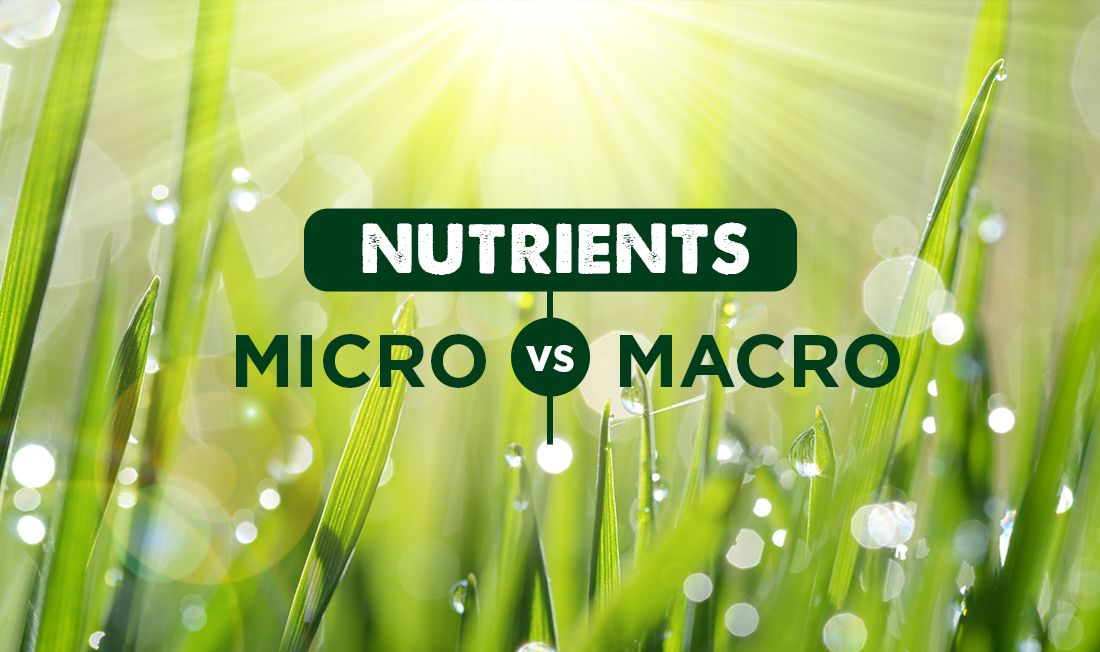There are 16 essential nutrients required for turfgrass, each of which have designated roles in the growth and reproduction process. While there are nutrients in addition to these 16 that can contribute to plant growth, these specific elements are considered “essential” because their absence can render a plant incapable of completing its life cycle, and their roles cannot be substituted by another nutrient. Three of these, carbon, hydrogen, and oxygen, are acquired naturally from the atmosphere and precipitation. The remaining fertilizer-applied nutrients are further broken down into two categories: micro and macro nutrients. The terms “micro” and “macro” refer to the general quantities of each required for successful growth.
Macro Nutrient VS Micro Nutrients
While it may be misleading, the terms “micro” and “macro” don’t designate a ranking of importance. Specifically, a macronutrient is the term for nutrients found in plant tissue at 1000 ppm or greater.
Micronutrients are found at concentrations of 100 ppm or less. Though they’re required in smaller amounts, micronutrients are just as important to plant growth as macronutrients.
Liebig's Law of the Minimum is a principle that states that plant growth is dictated by the most limiting nutrient. For example, if all nutrients are sufficient except for molybdenum, a micronutrient, then plants will exhibit deficiency symptoms and growth will be adversely affected, even though molybdenum is required in minimal amounts.

Primary vs. Secondary Macronutrients
Macronutrients are further categorized as primary and secondary macronutrients. Nitrogen, phosphorus, and potassium are considered primary macronutrients, while calcium, magnesium, and sulfur are secondary macronutrients. Primary macronutrients are consumed by plants in greater amounts than secondary macronutrients and are most frequently supplemented by fertilizer applications. Secondary macronutrients, calcium, magnesium, and sulfur, are consumed in greater quantities than micronutrients but less than primary macronutrients. They can often be found in greater supply in the soil and require less management than primary macronutrients.

What are Micronutrients?
Micronutrients consist of Iron, Zinc, Copper, Manganese, Boron, Molybdenum, and chlorine. Most micronutrients are metals and are found in abundance in fertile soils that are slightly acidic. As lawns are typically maintained at a pH closer to neutral, or 7, most micronutrients tend to become unavailable. In this case, foliar micronutrient applications are critical. More frequent micronutrient applications are also beneficial in sandy soil, as less fertile soils may not contain these nutrients in sufficient quantities.

Where to Purchase Macronutrient and Micronutrient Fertilizers?
Some scientists have explored alternative methods of classification rather than micronutrients and macronutrients. One such method would be to classify nutrients based on their biological roles in the plants, though this would be a bit arbitrary since these elements play multiple roles in physiological processes.
Simple Lawn Solutions has a variety of macronutrient formulations available for foliar and soil feeding, while options for micronutrient packages include our Darker Green, Micro-Booster, and Lawn Energizer products. Each will deliver exceptional nutrition for a healthy, luscious lawn.









